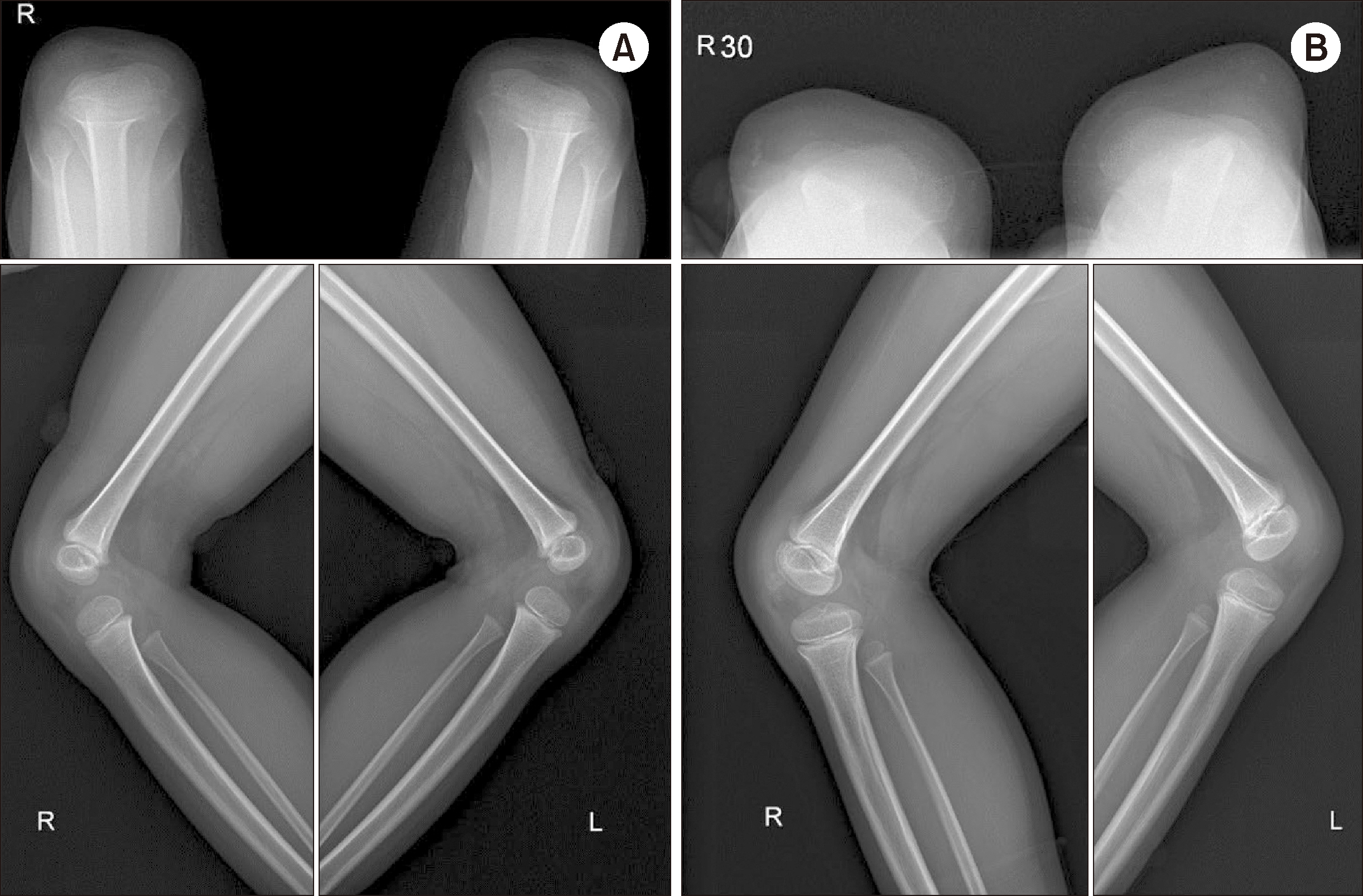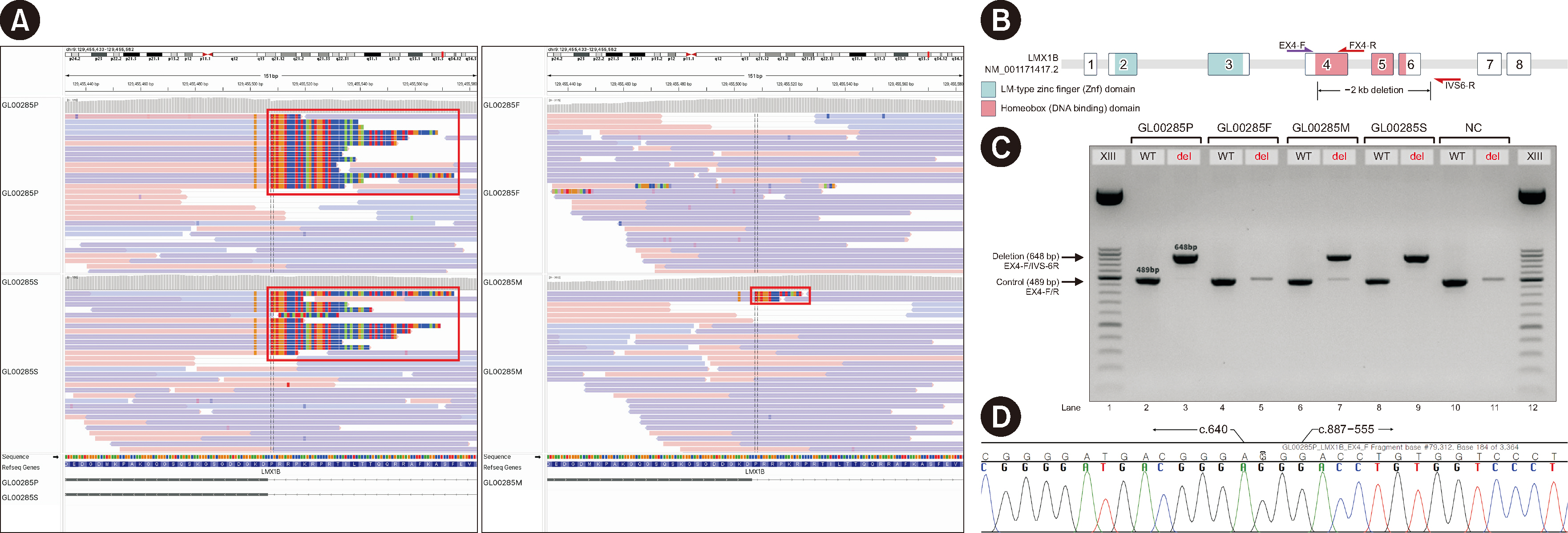Ann Lab Med.
2024 Nov;44(6):625-627. 10.3343/alm.2024.0140.
A Family With Nail-Patella Syndrome Caused by a Germline Mosaic Deletion of LMX1B
- Affiliations
-
- 1Department of Laboratory Medicine, Seoul National University Hospital, Seoul National University College of Medicine, Seoul, Korea
- 2Department of Pediatrics, Seoul National University Hospital, Seoul National University College of Medicine, Seoul National University Children’s Hospital, Seoul, Korea
- 3Cancer Research Institute, Seoul National University Hospital, Seoul, Korea
- KMID: 2560817
- DOI: http://doi.org/10.3343/alm.2024.0140
Figure
Reference
-
References
1. Marini M, Bocciardi R, Gimelli S, Di Duca M, Divizia MT, Baban A, et al. 2010; A spectrum of LMX1B mutations in Nail-Patella syndrome: New point mutations, deletion, and evidence of mosaicism in unaffected parents. Genet Med. 12:431–9. DOI: 10.1097/GIM.0b013e3181e21afa. PMID: 20531206.2. Richards S, Aziz N, Bale S, Bick D, Das S, Gastier-Foster J, et al. 2015; Standards and guidelines for the interpretation of sequence variants: a joint consensus recommendation of the American College of Medical Genetics and Genomics and the Association for Molecular Pathology. Genet Med. 17:405–24. DOI: 10.1038/gim.2015.30. PMID: 25741868. PMCID: PMC4544753.3. Riggs ER, Andersen EF, Cherry AM, Kantarci S, Kearney H, Patel A, et al. 2020; Technical standards for the interpretation and reporting of constitutional copy-number variants: a joint consensus recommendation of the American College of Medical Genetics and Genomics (ACMG) and the Clinical Genome Resource (ClinGen). Genet Med. 22:245–57. DOI: 10.1038/s41436-019-0686-8. PMID: 31690835. PMCID: PMC7313390.4. Seol J-H, Shim EY, Lee SE. 2018; Microhomology-mediated end joining: Good, bad and ugly. Mutat Res. 809:81–7. DOI: 10.1016/j.mrfmmm.2017.07.002. PMID: 28754468. PMCID: PMC6477918.5. Yan X, Lin J, Wang Y, Xuan J, Yu P, Guo T, Jin F. 2019; A novel small deletion of LMX1B in a large Chinese family with nail-patella syndrome. BMC Med Genet. 20:DOI: 10.1186/s12881-019-0801-3. PMID: 31053111. PMCID: PMC6499979. PMID: 23a353489c1046babe7fe5e5d85b6a98.6. Sato U, Kitanaka S, Sekine T, Takahashi S, Ashida A, Igarashi T. 2005; Functional Characterization of LMX1B Mutations Associated with Nail-Patella Syndrome. Pediatr Res. 57:783–8. DOI: 10.1203/01.PDR.0000157674.63621.2C. PMID: 15774843.7. Gerasimavicius L, Livesey BJ, Marsh JA. 2022; Loss-of-function, gain-of-function and dominant-negative mutations have profoundly different effects on protein structure. Nat Commun. 13:DOI: 10.1038/s41467-022-31686-6. PMID: 35794153. PMCID: PMC9259657. PMID: 25ec647fd0494726b71c4fe1559ad371.8. Bongers EMHF, De Wijs IJ, Marcelis C, Hoefsloot LH, Knoers NVAM. 2008; Identification of entire LMX1B gene deletions in nail patella syndrome: evidence for haploinsufficiency as the main pathogenic mechanism underlying dominant inheritance in man. Eur J Hum Genet. 16:1240–4. DOI: 10.1038/ejhg.2008.83. PMID: 18414507.9. Xu N, Shi W, Cao X, Zhou X, Jin L, Huang H-F, et al. 2023; Parental mosaicism detection and preimplantation genetic testing in families with multiple transmissions of de novo mutations. J Med Genet. jmg-2022-108920:DOI: 10.1136/jmg-2022-108920. PMID: 36707240. PMCID: PMC10447385.10. Campbell M, Ian , Stewart R, Jonathan , James A, Regis , Lupski R, James , Stankiewicz P, Olofsson P, Shaw A, Chad . 2014; Parent of Origin, Mosaicism, and Recurrence Risk: Probabilistic Modeling Explains the Broken Symmetry of Transmission Genetics. Am J Hum Genet. 95:345–59. DOI: 10.1016/j.ajhg.2014.08.010. PMID: 25242496. PMCID: PMC4185125.



